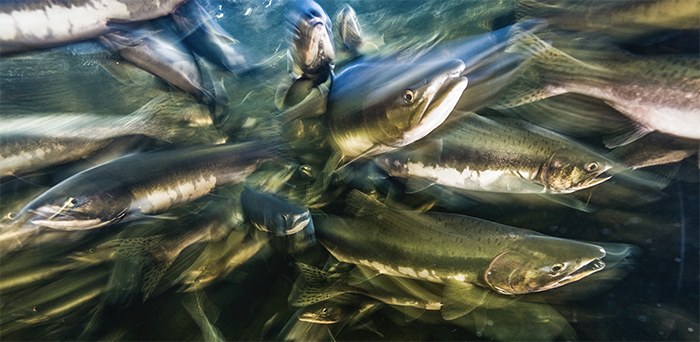
Peter Zeihan: Europe Goes Nuclear
We’ve got two major developments in Eurasia. We’re talking about Ukraine disabling two ships in the Caspian Sea and Poland getting EU approval to build…
Thought Leader: Peter Zeihan

Taking a deep breath, I plunge into the crystalline waters of the Pacific Ocean, and for a moment, I am immersed in a sea of bubbles, slowly sinking into an exhilarating bath of blue champagne.
The empty expanse of water seems devoid of life at first; the only movement comes from the rays of sun that dance in a refracted ballet just below the surface. I peer into the dark shadows that loom below me, just beyond the edge of visibility, and see nothing but blue hues fading to black. It is not giant sea monsters that I am looking for, but the millions of tiny creatures, mostly transparent, and many no larger than my small finger, that make up the foundation of life in our oceans. I drift with the current, floating on the surface, and for a few minutes, I am part of an almost invisible, yet immense planktonic community.
The first ten meters below the surface are all I can reach with the air in my lungs, but it is in this slim, sunlit layer that the multitude aspects of life in our oceans are linked together, through a series of interlocking, fragile and delicately adjusted relationships. The fate of a diatom, a tiny unicellular algae that floats with the plankton in the upper layer of the sea, may very well determine the destiny of a lingcod hiding within a crevasse in some rocky canyon twenty fathoms below.
Through still mysterious activities and processes, the plankton makes the mineral wealth of the seawater available to all other animals. Marine protozoa, crustaceans, young crabs, barnacles, sea worms, small fish, larvae, and many other tiny sea creatures feed on the diatoms and other minute single-cell algae as they float together at the mercy of the currents. Within this briny broth, gangs of small carnivores, the first link in the chain of flesh eaters, swim alongside peaceful herds of plant-eaters.
There are tiny, voracious creatures that are barely a few millimeters long, sharp-jawed arrow worms, delicate unicellular and perfectly symmetrical Radiolaria, and translucent comb jellies that despite their deceiving beauty are armed with deadly tentacles to entrap their fellow travelers. Miniature copepods and shrimp-like euphausiids, also known as krill, strain food from the water with their bristly extremities and are essentially the fuel that runs the engine of Earth’s marine ecosystems.
Together, this minuscule menagerie drifts with no power or will to oppose that of the sea. Mighty currents, like the Kuroshio, carry over 50 million tons of seawater past the southern coast of Japan out into the Pacific. Its flow, equal in volume to 6,000 rivers, is rich in plankton, and eventually merges with the Northern Pacific Current to form one of our planet’s largest and most important ecosystems; a carbon sink of such vast proportions that life on Earth would almost certainly be impossible were it not for its existence. Indeed, much of the oxygen we breathe comes from just one species of cyanobacteria floating in the plankton; a creature so tiny that millions can fit into a single drop of water.
In fact, the oxygen made by these microscopic marine plants dwarfs that produced by the Amazon rainforest and the rest of the world’s woodlands combined. By taking in carbon dioxide and exhaling oxygen, these tiny creatures serve as the planet’s lungs, whose steady breathing is limited only by the health and productivity of the ocean.
From the plankton, the food chain leads on upwards to the schools of plankton-eating fishes like herring, sardines, anchovies, and hake, followed by the larger carnivorous fishes, like the tuna, sharks and cod. Then to the great whales, which depending on their species, but not necessarily according to their size, thrive on other sections of the food chain, like marine mammals, fishes or krill or even on some of the smallest members of the plankton. Wherever the swarms of shrimp-like krill go to spawn, the humpback whales, sharks, porpoises, squid, sea lions, and seals suddenly arrive on the coastal banks of every ocean.
Then, on the first tide of spring, the tiny shell of the new moon that brings the water lapping onto land and drenches the sea oats that fringe the rocky seashore, announces the arrival of the fish.
Herring off the coasts of the northeastern Pacific, sardines on the shores of Africa, menhaden on the eastern seaboard of North America, and anchovies along the beaches of South America make their yearly pilgrimage to the shallows to spawn. Mostly at night, but occasionally during broad daylight, the shoals of these small fish hurrying towards shore will shoot out of the water and glide through the air, sometimes over long distances, until they lose the speed they accumulated underwater and eventually fall helplessly back into the ocean.
The relentless paths of the powerful currents and the wind, along with the very rotation of the Earth, blow the surface waters away from the shore and allow the upwelling of cold, nutrient-rich waters. This is the salty bouillabaisse that helps the plankton thrive, and supports the health and growth of these massive schools of fish during the spring.
When the skin of the sea is so calm that it holds the colors of the evening sky on its surface, a million little fish swim up against the liquid film, dimpling this glassy sheet of water, and precipitating a great flurry of commotion by all kinds of predators. Myriad seabirds — fulmars, petrels, gulls and even albatrosses — come from the far reaches of the open sea to participate in this yearly spring feast along the coasts. Other birds like eagles, kingfisher, and osprey, also arrive to get their share.
By day, the fish move quickly through the coastal waters, but as the waters turn silver and black, they follow the dark channels between the rocky canyons looking for beds of kelp or rocky shallows on which to spawn their eggs. The masses of eggs and sperm turn the seawater into a milky emulsion that is consumed by crustaceans, fishes and seabirds alike. Once they are finished spawning, the fish will return to the depths from which they came from, but not before supporting some of the largest fisheries on our planet. Thousands of boats will head out to sea every spring to fill their nets with these small fish. The wealth of animal protein these fisheries provide is one of our planet’s most valuable resources, and because so many lives, human and otherwise, depend on it, it should be managed with infinite care and caution.
Larger carnivorous fish, like salmon, also come ashore from the vastness of the open ocean. They arrive in mighty pulses and almost overnight, the sea is filled with migrating fishes — beautiful, silvery torpedoes bound for the mouths of great rivers.
The salmon will painstakingly ascend to a shallow creek bed in the same river where they hatched and spent the first few months of their lives, and there, they will deposit their own spawn, just as many generations before them. The returning salmon only vaguely “remember” the river; their memory an awareness that is perceived through their delicate gills and lateral lines, of a lessening saltiness in the water.
These are the carnivorous fish that arrive in Coho, Chinook, Sockeye and Steelhead tribes from their far away Pacific feeding grounds to meet the rolling creeks of the coast of California, Oregon, and British Columbia. The endless landscapes of the sea where they have been feeding, are all these fish have known since they left the stream. Now, following invisible clues and mysterious maps that only they know, they head back to their spawning grounds in the very same rivers where they were born.
Knowingly or not, large economies and millions of people depend on the small creatures of the plankton and the return of the schools of forage fish, the salmon, the squid, and even the whales. Nearly three billion people worldwide, or one in every three people, receive twenty percent of their daily animal protein intake from fish, and millions of others, working in related industries, also make their living from the sea.
For these few weeks in the late spring and early summer, the surface of the ocean brims with planktonic life, and the plants that floated dormant all through the winter come back to life and begin to multiply.
At first, the spring sea belongs to the diatoms and other small algae. Soon, however, the fierce intensity of their growth allows these minute plants to spread over vast expanses of the sea, lending vibrant color to the water with their own pigments. Then, almost at once, hungry swarms of many different creatures arrive and multiply. But all cycles must come to an end, and as summer draws to a close, the voracious foraging of so many grazers will inevitably deplete these planktonic blooms.
Life in the ocean, stunning and humbling even in its smallest expression, is the primordial engine that transforms the land, shapes our continents, gives birth to entire coastlines, and creates new life on this planet. As the days ebb from the warmth of summer into the dormancy of winter, the surface waters will once again grow still, and life will slacken to a slower pace, just waiting for the first tide of spring to begin its dance again.
Peter Zeihan: Europe Goes Nuclear
We’ve got two major developments in Eurasia. We’re talking about Ukraine disabling two ships in the Caspian Sea and Poland getting EU approval to build…
Thought Leader: Peter Zeihan
Dr. Sanjay Gupta’s Top Health Stories of 2025
From the resurgence of measles to a new way to treat pain, 2025 was a challenge for public health while still offering moments of hope. Sanjay…
Thought Leader: Sanjay Gupta
Ian Bremmer: The state of global conflict in 2025
On GZERO World, Ian Bremmer takes a hard look at the biggest global crises and conflicts that defined our world in 2025 with CNN’s Clarissa…
Thought Leader: Ian Bremmer

